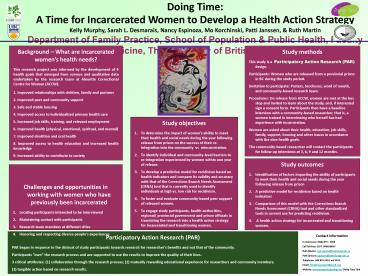Doing Time: - PowerPoint PPT Presentation
1 / 1
Title:
Doing Time:
Description:
Department of Family Practice, School of Population & Public ... This research project was informed by the development of 9 ... Improved dentition and ... – PowerPoint PPT presentation
Number of Views:46
Avg rating:3.0/5.0
Title: Doing Time:
1
Doing Time A Time for Incarcerated Women to
Develop a Health Action Strategy Kelly Murphy,
Sarah L. Desmarais, Nancy Espinoza, Mo
Korchinski, Patti Janssen, Ruth
Martin Department of Family Practice, School of
Population Public Health, Faculty of Medicine,
The University of British Columbia
Background What are incarcerated womens health
needs? This research project was informed by the
development of 9 health goals that emerged from
surveys and qualitative data undertaken by the
research team at Alouette Correctional Centre for
Women (ACCW) 1. Improved relationships with
children, family and partners 2. Improved peer
and community support 3. Safe and stable
housing 4. Improved access to individualized
primary health care 5. Increased job skills,
training, and relevant employment 6. Improved
health (physical, emotional, spiritual, and
mental) 7. Improved dentition and oral health 8.
Improved access to health education and increased
health knowledge 9. Increased ability to
contribute to society
Study methods This study is a Participatory
Action Research (PAR) design. Participants Women
who are released from a provincial prison in BC
during the study period. Invitation to
participate Posters, brochures, word of mouth,
and community-based research team. Procedures On
release from ACCW, women are met at the bus stop
and invited to learn about the study, and, if
interested sign a consent form. Participants then
have a baseline interview with a community-based
researcher, that is, a women trained in
interviewing who herself has had experience with
incarceration. Women are asked about their
health, education, job skills, family, support,
housing and other issues in accordance with the
nine health goals. The community-based researcher
will contact the participants for follow-up
interviews at 3, 6, 9 and 12 months.
- Study objectives
- To determine the impact of womens ability to
meet their health and social needs during the
year following release from prison on the success
of their re-integration into the community vs
reincarceration. - To identify individual and community-level
barriers to re-integration experienced by women
within one year of release. - To develop a predictive model for recidivism
based on health indicators and compare its
validity and accuracy with that of the
Corrections Branch Needs Assessment (CRNA) tool
that is currently used to identify individuals at
high vs. low risk for recidivism. - To foster and evaluate community-based peer
support of released women. - To engage study participants, health authorities,
regional/ provincial government and prison
officials in translating the research into a
health action strategy for incarcerated and
transitioning women.
- Study outcomes
- Identification of factors impacting the ability
of participants to meet their health and social
needs during the year following release from
prison - A predictive model for recidivism based on health
indicators - Comparison of this model with the Corrections
Branch Needs Assessment (CRNA) tool and other
standardized tools in current use for predicting
recidivism. - A health action strategy for incarcerated and
transitioning women.
- Challenges and opportunities in working with
women who have previously been incarcerated - Locating participants interested to be
interviewed - Maintaining contact with participants
- Research team members at different cities
- Honoring and respecting diverse peoples
experiences
Participatory Action Research (PAR) PAR began in
response to the distrust of study participants
towards research for researchers benefits and
not that of the community. Participants own the
research process and are supported to use the
results to improve the quality of their lives. 3
critical attributes (1) collaboration through
the research process (2) mutually rewarding
educational experience for researchers and
community members (3) tangible action based on
research results.
Contact information In Vancouver (604) 875
3658 Call Toll-free 1877 84WOMAN Ruth Martin
ruth.martin_at_familymed.ubc.ca Patti Janssen
pjanssen_at_interchange.ubc.ca Telephone 604
875-2424, ext 5415 Email doingtimeproject_at_gmail.c
om Website www.womenin2healing.org Doing Time
link































